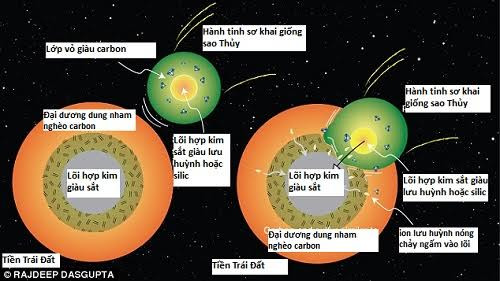A collision can start life on Earth
According to geochemists, the element that originated on life on Earth is carbon, which could be brought from a collision with another planet 4.4 billion years ago.
According to the BBC, scientists believe that an asteroid of about 4,828 km in diameter may have collided with and merged with the Earth 4.4 billion years ago, the early period of the Earth, bringing resources whether it is necessary for life and even precious crystals like diamonds.
The cause of the surface and the Earth-rich crust is still a big question for geochemists, since most of the Earth's carbon in the early days was evaporated or confined to the core.
"The challenge here is to explain the origin of volatile elements such as carbon that are retained on the Earth's outer shell," said Dr Rajdeep Dasgupta, a rock researcher, Rice University. Houston, USA, said.
"We have published a number of studies that show that if not evaporated into space when most of the planet is in molten form, carbon will be absorbed by iron-rich alloys in the core."
In the September 5 issue of the journal Nature, the team describes experimental content under high pressure to test whether sulfur and silicon can break down iron-carbon bonds. The results show that carbon can escape from the core and onto the surface, mostly in the form of silicate, if the iron-containing alloy in the silicon-rich core or sulfur.

Describe the collision process.(Photo: Rajdeep Dasgupta).
When the team arranged carbon concentrations to occur under different sulfur and silicon enrichment levels and compared with the data obtained in the Earth's crust, a compelling scenario appeared.
"A scenario to explain the carbon-sulfur ratio and the abundance of carbon is a Mercury-like early planet, with silicon-rich cores colliding and being absorbed by the Earth , " Mr. Dasgupta said.
"Because this is a giant object, the dynamic process may have taken place in the way that the core of the planet directly collided with the Earth's core, and the carbon-rich shell mixed with the Earth's crust."
"This scenario can at least explain Earth's current carbon and sulfur levels , " Dasgupta said.
This finding is consistent with the theory of Moon formation, about 4.5 billion years ago by a planet called Theia that collided with Earth.
In addition, many scientists believe that life, or at least complex components such as water and amino acids, are brought to Earth by asteroids and comets.
"A popular concept is that volatile elements such as carbon, sulfur, oxygen and hydrogen are brought to Earth after the core has formed , " said Dr. Yuan Li, the lead author of the new study. a geochemist at the Chinese Academy of Sciences, said.
"Any element that falls to Earth during the 100 million years of solar system formation can avoid the intense heat from the lava oceans that cover the Earth up to that point."
However, the problem with this hypothesis is that although it explains the abundance of these elements, no meteorite has yet been able to produce a proportion of volatile elements similar to the composition. Earth silicate.
- Has the diverse ecosystem on Earth been born from planetary collisions?
- Meteors are not enough to destroy life on Earth
- Life may start on Venus
- 7 perspective of the destruction of the Earth
- More evidence of the origin of the Moon
- Collisions bring gold and platinum to Earth
- The moon is 95 million years later than the solar system
- The collision destroyed more than 3 billion years ago
- The collision with the galaxy is 350 million light-years from Earth
- Comet 26km wide can destroy the Earth in 4479
- Life on Earth begins with volcanoes?
- Life of dinosaurs so far without extinction
 Van Allen's belt and evidence that the Apollo 11 mission to the Moon was myth
Van Allen's belt and evidence that the Apollo 11 mission to the Moon was myth The levels of civilization in the universe (Kardashev scale)
The levels of civilization in the universe (Kardashev scale) Today Mars, the sun and the Earth are aligned
Today Mars, the sun and the Earth are aligned The Amazon owner announced a secret plan to build a space base for thousands of people
The Amazon owner announced a secret plan to build a space base for thousands of people What would happen if you dug a hole through the Earth and jumped in?
What would happen if you dug a hole through the Earth and jumped in?  Chilling discovery of cosmic object that almost brought the Earth to 'apocalypse'
Chilling discovery of cosmic object that almost brought the Earth to 'apocalypse'  The Sun goes into hibernation, will the Earth usher in a new ice age?
The Sun goes into hibernation, will the Earth usher in a new ice age?  Discovery of space object powerful enough to tear apart the Earth
Discovery of space object powerful enough to tear apart the Earth  NASA to test 'pneumatic brakes' for Mars lander
NASA to test 'pneumatic brakes' for Mars lander  Breakthrough discovery of planet with more water than Earth
Breakthrough discovery of planet with more water than Earth 